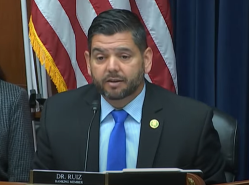Ranking Member Ruiz’s Opening Statement at Select Subcommittee Hearing on School Closures
Washington, D.C. (March 28, 2023)—Below is Ranking Member Raul Ruiz's, M.D. opening statement, as prepared for delivery, at today's Select Subcommittee on the Coronavirus Pandemic hearing examining school closures during the coronavirus pandemic.

Click here to watch the video.
Opening Statement
Ranking Member Raul Ruiz, M.D.
Select Subcommittee on the Coronavirus Pandemic
Hearing on "The Consequences of School Closures: Intended and Unintended"
March 28, 2023
Thank you, Mr. Chairman.
Let me begin by expressing my condolences to the parents and families who lost a loved one yesterday at Covenant School in Nashville.
As we grieve the loss of another six lives to the epidemic of gun violence in America, we must act beyond condolences and enact common-sense reforms that put our children and communities first.
I'll now turn my attention to another issue of critical importance for our children's health, safety, and well-being.
Over the last three years, the impact of the COVID-19 pandemic on our nation's children has weighed heavily on the minds of parents, students, educators, and Americans all across the country. As a physician and a father, it's certainly been at the top of mine.
Today, I hope that we make progress on identifying evidence-based solutions to help America's children live and learn healthily and safely.
In this work, our goal must be to make our schools resilient for the next highly contagious, lethal virus so that we can keep schools open, protect students and teachers, prevent outbreaks, and reduce transmission of the virus in our communities.
We must help children cope with the anxiety, depression, and trauma they experienced during the pandemic, which continue to impact their mental health and academic performance to this day. My heart breaks for the many suffering from anxiety and depression, and families who lost a son or daughter from suicide. We must also identify ways to help students not only catch up in school but also excel in the future.
To do right by our nation's parents, students, and educators, we must have an honest conversation today. One that is objective, guided by compassion, and led by facts and science. That includes taking a comprehensive approach to examining actions taken in the earliest days of this public health crisis.
From the beginning, President Trump and his Administration did not act with the urgency needed to reduce transmission, communicate honestly with the American public, and equip our schools with the resources they needed.
Instead of working to efficiently manufacture PPE, scale up testing, and promote basic public health measures like masking and social distancing, President Trump chose to politicize this virus, calling it a hoax and downplaying its severity—saying it would go away like the flu.
But as the coronavirus reached pandemic proportions, public officials of all political persuasions had to act to suspend in-person learning—slowing the transmission of an airborne virus that easily spreads in close, confined spaces like classrooms.
The Trump Administration's early failures resulted in the prolonged suspension of in-person learning. So much so that when January 2021 rolled around, less than half of America's schools were open for full-time in-person learning.
President Biden took a different approach. The Biden Administration took swift action to develop evidence-based guidance for schools. And Congressional Democrats enacted the American Rescue Plan to help get kids in schools safely and responsibly.
The results speak for themselves. One year after President Biden was sworn into office, our efforts more than doubled the number of schools open for full-time in-person learning to 95%. And schools didn't just reopen—they stayed open.
Today, more than 99% of schools in the United States have safely and responsibly reopened for in-person learning. This is a direct result of the American Rescue Plan's targeted investments in childhood education to keep students healthy and safe while they learn. In fact, key funding from the American Rescue Plan is already at work, rebuilding schools' crumbling infrastructure, upgrading their ventilation systems, and getting students the resources they need.
I'll give you an example.
Coachella Valley Unified School District—where I went to school—is putting $2 million of their funding toward making critical upgrades of air purification systems that can filter out viruses so that kids can breathe cleaner air in their classrooms.
The American Rescue Plan also included strong provisions to not just get kids back in school, but also to make up for lost classroom time—requiring that 20 percent of all funds go toward addressing learning loss.
Again, CVUSD in my district is investing nearly $600,000 for instructional support and over $1.8 million for emotional and behavioral health support. We should look to build on this progress.
So let's not turn our backs on lifesaving public health measures that reduced transmission in schools and our communities, including:
- Vaccines, which have saved more than 3 million lives and prevented nearly 120 million COVID-19 infections in the United States as shown in a Commonwealth Fund Study;
- Social distancing—which, if not in place, would have resulted in a thirty-five times greater spread of COVID-19 between March and April of 2020 according to a peer-reviewed report in Health Affairs; and
- Effective mask-wearing, which researchers at Duke University found was associated with a 72% reduction of in-school COVID-19 cases.
-
We should aim to put people over politics and work together to prioritize our children's health and well-being both inside and outside the classroom. Because when we do just that, we will set our kids up for success and help them thrive now and into the future.
###